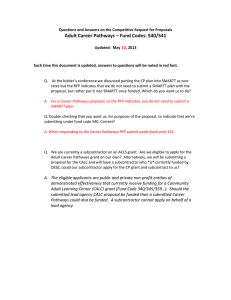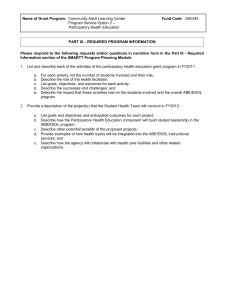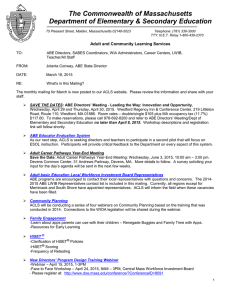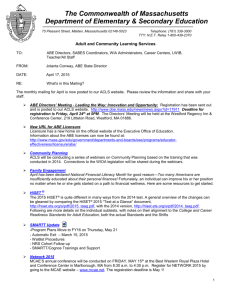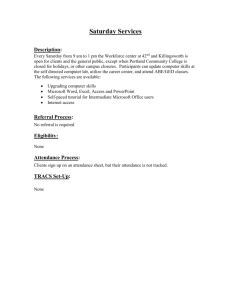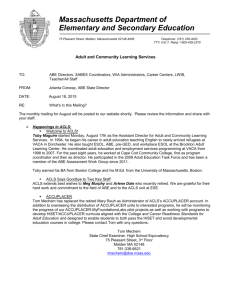The SMARTT system is a management tool for local programs as
advertisement
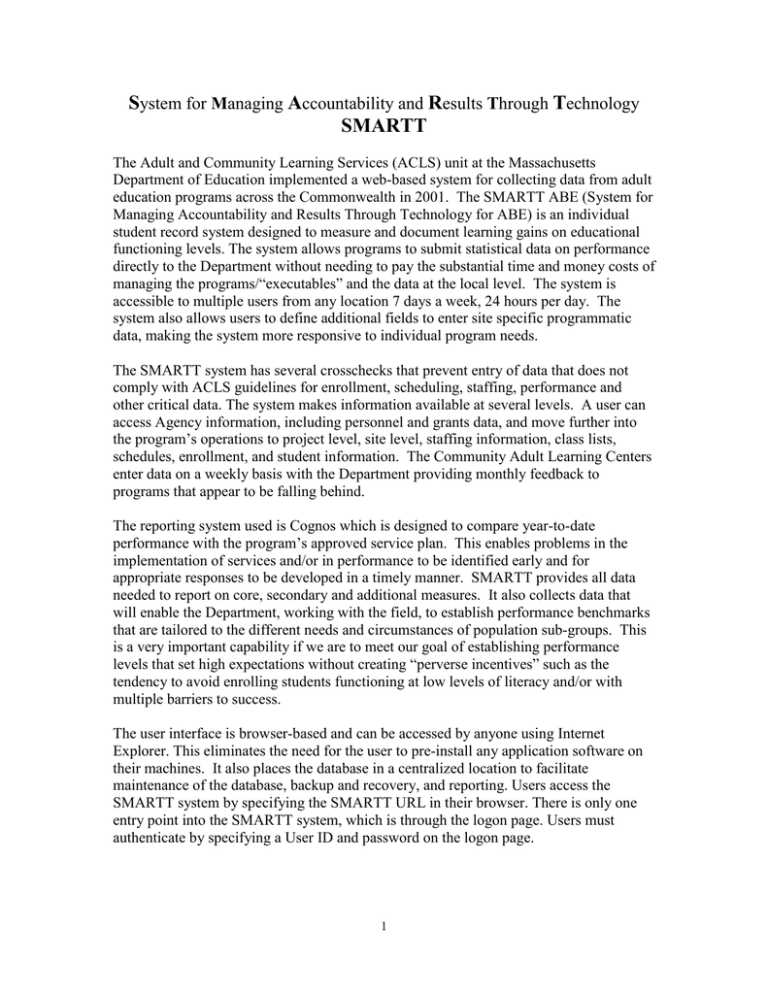
System for Managing Accountability and Results Through Technology SMARTT The Adult and Community Learning Services (ACLS) unit at the Massachusetts Department of Education implemented a web-based system for collecting data from adult education programs across the Commonwealth in 2001. The SMARTT ABE (System for Managing Accountability and Results Through Technology for ABE) is an individual student record system designed to measure and document learning gains on educational functioning levels. The system allows programs to submit statistical data on performance directly to the Department without needing to pay the substantial time and money costs of managing the programs/“executables” and the data at the local level. The system is accessible to multiple users from any location 7 days a week, 24 hours per day. The system also allows users to define additional fields to enter site specific programmatic data, making the system more responsive to individual program needs. The SMARTT system has several crosschecks that prevent entry of data that does not comply with ACLS guidelines for enrollment, scheduling, staffing, performance and other critical data. The system makes information available at several levels. A user can access Agency information, including personnel and grants data, and move further into the program’s operations to project level, site level, staffing information, class lists, schedules, enrollment, and student information. The Community Adult Learning Centers enter data on a weekly basis with the Department providing monthly feedback to programs that appear to be falling behind. The reporting system used is Cognos which is designed to compare year-to-date performance with the program’s approved service plan. This enables problems in the implementation of services and/or in performance to be identified early and for appropriate responses to be developed in a timely manner. SMARTT provides all data needed to report on core, secondary and additional measures. It also collects data that will enable the Department, working with the field, to establish performance benchmarks that are tailored to the different needs and circumstances of population sub-groups. This is a very important capability if we are to meet our goal of establishing performance levels that set high expectations without creating “perverse incentives” such as the tendency to avoid enrolling students functioning at low levels of literacy and/or with multiple barriers to success. The user interface is browser-based and can be accessed by anyone using Internet Explorer. This eliminates the need for the user to pre-install any application software on their machines. It also places the database in a centralized location to facilitate maintenance of the database, backup and recovery, and reporting. Users access the SMARTT system by specifying the SMARTT URL in their browser. There is only one entry point into the SMARTT system, which is through the logon page. Users must authenticate by specifying a User ID and password on the logon page. 1 The SMARTT system is a management tool for local programs as well as providing data at the state and federal level. Features of the system that assist programs with data management are: Program Planning – utilizes the rates system to determine funding amounts and provides the basis for completing the refunding package Wait List – maintains waiting list data and allows programs to project future needs System Reports - assessment reports that calculate pre/post rates which assist programs to comply with our performance standard to pre and post test students - follow-up reports that assist programs in determining if students goals were met and complying with NRS requirements - attendance reports that show percent attendance based on funded class hours Cognos Reporting Tool – third party tool with data cubes that lists student demographics and participation data such as number of students, hours attended, goals attained, federal reports, etc. ABE Directory – lists all funded programs with contact information, class schedule, seats available, and current wait list data Value of the System at the Local Level: Tool for program design that calculates eligible cost, student hours, cost per student, etc. Tool to assist programs in tracking student attendance, goal attainment, and student progress Gives programs a quantitative view of the data at any point in time and for multiple categories Allows programs to maintain waiting list data and project future program needs Value of the System at the State Level: Provides up to date wait list information by service type and level so that the state can lobby for additional funding Allows the state to have an accurate updated picture of program’s level of compliance of our guidelines to make equitable funding decisions Provides current program information regarding performance measures such as student participation, student goal attainment, and student learning gains Provides follow-up information required under NRS Features that Allow Management of Data at the Local Level: User Defined Fields (fields that users design at the student, staff, volunteer, and class level). These fields are yes/no, text, date, and number. Combo Box (a drop down list box and a text field). Users can select one of the existing values or type a new one. If a new one is typed, it appears the next time. This feature allows programs to customize data collection at the local level. 2 Hierarchical Access Levels (four levels of access to view and edit information). This feature gives programs the capability of assigning access levels to various types of data entry staff. For example, a site user can only view and enter information at the site level while an agency coordinator can view and edit staff, classes, and agency information. It is important that confidential information be available to only certain staff members. Features That Facilitate the Ease of Data Entry and Use: Required Fields – fields that must be filled in before the information on the screen can be saved. Fields that provide information needed to compile the federal report as well as information needed at the state level to make funding decisions and requests are marked as required. Error Tables – tables that appear if the user does not enter all the required information or if the format is incorrect. The table lists the field name where the error occurred and gives a message indicating what is needed to correct the error. Lookup Tables – tables that provide information if the user does not know the info requested. For example, if the user did not know the zip code for a city, he/she would select the “Lookup” button and a table would appear listing all the zip codes and corresponding cities. The user then highlights the selection and the information is entered. Feedback Form – a form that allows users to give feedback in three ways: comments, enhancement requests, and defects. The information is sent to the database with the time as well as User ID recorded. The production support member of the team reviews the feedback comments and channels them to the appropriate person. FAQ Section – a section that lists frequently asked questions with answers. Welcome Screen Notices – the screen shows any SMARTT news of the day and lists the current software version. 3
